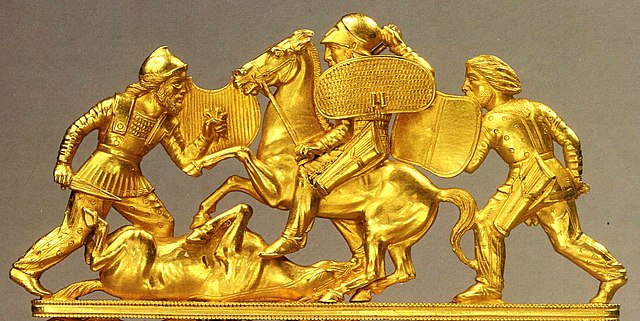I’ve decided to break the fourth episode into two parts, as it was getting quite long. So this is the first half of the fourth and final episode of our series on the Amazons (I, II, III).
So far we have covered their mythical origins, the geography of their homeland, and their historical counterparts: the Kaska.
But, if you’re like me, you may be asking: what ever happened to the Amazons?
We will answer that question in this episode. We will also explore how this legendary tribe was rediscovered by the Greeks, and how they made that long leap from mythical to historical.
As always, if you like this content and want to know when a new episode is posted, you can leave your email below!
And if you know anyone who might enjoy these posts, please feel free to share.
Later History
In our last episode, we showed that the Amazons were almost certainly the same people as the Kaska of northern Anatolia. The Hittite name for them was Kaska, while the Greeks called them Amazons.[A]
We will examine all the evidence we have of the migration of both the Kaska and the Amazons. This will help us determine what happened to the Amazons in the several centuries between the Heroic Age and Classical Antiquity.
Kaska Migration
From the Hittite records we have, the Kaska were last mentioned in the reign of the Hittite king Hattusili III (1275 – 1245 BC). After his reign, Hittite documents become somewhat rare. So there may very well have been later documents about the Kaska, but they have not been found.
The Hittite Empire collapsed at the start of the 12th century BC. When the Hittites abandoned their capital, Hattusa, they brought their most recent records with them. We do not know where the Hittite capital was relocated to, and therefore do not know much about the events surrounding the collapse of their empire.
Nonetheless, it is assumed that the Kaska contributed to the fall of the Hittite Empire. This is due to their proximity to the Hittite heartland and their three-centuries-long conflict with the Hittites.
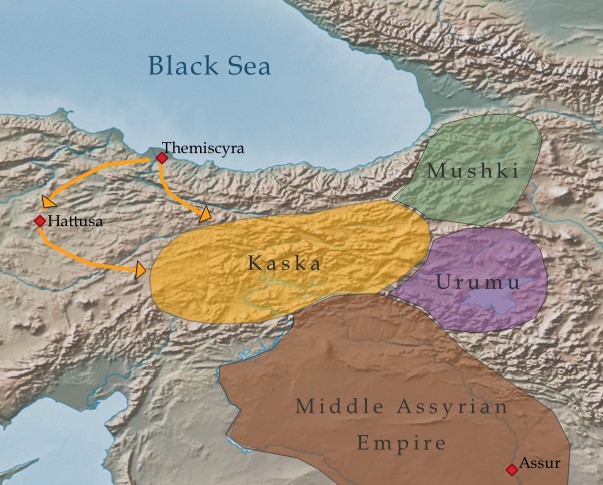
This idea is reinforced by the fact that the Kaska are mentioned in Assyrian documents in the 12th century BC. Assyrian texts state that the Kaska reached as far east as the upper Euphrates River and inhabited eastern Anatolia by this time.[1] The Assyrian king Tiglath-Pileser I (1115 – 1093 BC) defeated the Kaska and their allies (the Mushki and Urumu people) in the upper Tigris region.[2][B]
So these Assyrian reports show that the Kaska migrated from northern Anatolia into eastern Anatolia after the Late Bronze Age Collapse.[C]
Amazon Migration
Now let’s take a look at the Kaska’s legendary counterparts, the Amazons.
Strabo claimed that an all-male tribe, called the Gargarians, had originally “lived with” the Amazons in Pontus and migrated with them north of the Caucasus Mountains.
“Metrodorus of Scepsis and Hypsicrates, who were acquainted with the region in question, say that the Amazons live on the borders of the Gargarians in the northerly foothills of those parts of the Caucasian Mountains which are called the Thunderers.”
“It is said that the Gargarians went up from Themiscyra into this region with the Amazons, then revolted against them and made a compact that they should have dealings with one another only in the matter of children, and that each people should live independent of the other.” [3]
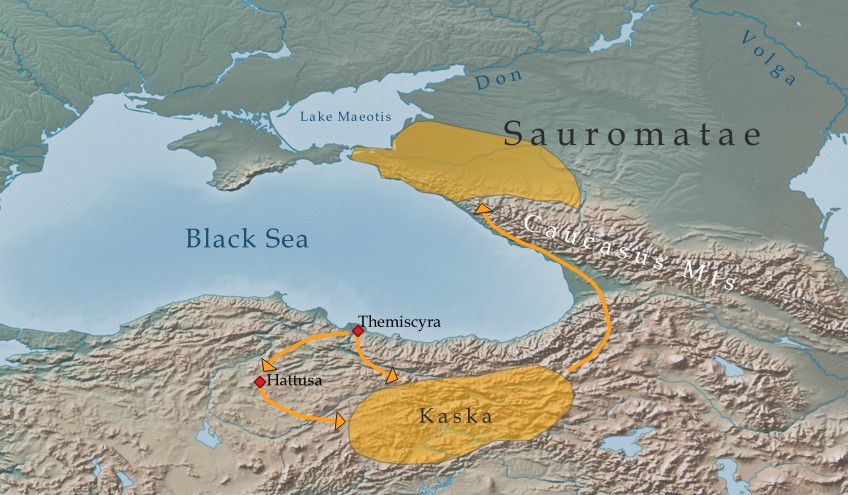
Herodotus claims that the Amazons came to inhabit this region between the Caucasus and Lake Maeotis.[4] Ephorus specifies that the Amazons mixed with the Sauromatae, a loose tribal confederation between the Don and Volga rivers.[5] This is also repeated by Scymus of Chios, Plato, and Diodorus Siculus.[6,7,8]
All told, these accounts claim that the Amazons migrated eastward from the Thermodon River toward the Caucasus Mountains. This matches the eastward movement of the Kaska recorded by the Assyrian in the 12th century BC.
On the Move
This migration must have occurred no later than the 6th century BC, as Herodotus reports on it, and Greek colonies in this region were not established until this time.
The last Assyrian mention of the Kaska occurs during the reign of Sargon II (722 – 705 BC).[2] Scythians conquered West Asia just a few decades later, reaching as far as Egypt. But by the end of the 7th century BC, these Scythian tribes retreated north of the Caucasus Mountains.
It has been speculated that the Sauromatae were part of this migration at the end of the 7th century BC.[9] In other words, the Amazons likely migrated from eastern Anatolia to the northern foothills of the Caucasus at this time.
Sauromatae
The Sauromatae confederation inhabited the region between the Volga and Don rivers from the 6th – 4th centuries BC. Herodotus says that they spoke a corrupt form of the Scythian language.[4]
But what is interesting about the Sauromatae are their gender customs. Pomponius Mela has this to say about the people who lived along the eastern coast of Lake Maeotis in his lifetime:
“Women practice the same skills as men, so much so that women are not free even from military service.” … “Women remain virgins until they have killed an enemy.” [10]
He continues by saying that one of these tribes, part of the Sauromatae confederation, was ruled by women, and he explicitly calls them Amazons.
And such claims are backed up by a ton of archaeological evidence. For instance, twenty percent of Sauromatae graves in this region are burials of female warriors.[11]
But suffice it to say the historical, legendary, and archaeological evidence all point to the existence of Amazon tribes on the northeast shore of the Black Sea during Classical Antiquity.
Greek Colonization
Greek colonies did not appear on the Black Sea until the 8th century BC. And colonies in the region between Lake Maeotis and the Caucasus — the land of the Sauromatae — were not founded until the 6th century BC. As we will see, that date will be important to keep in mind.
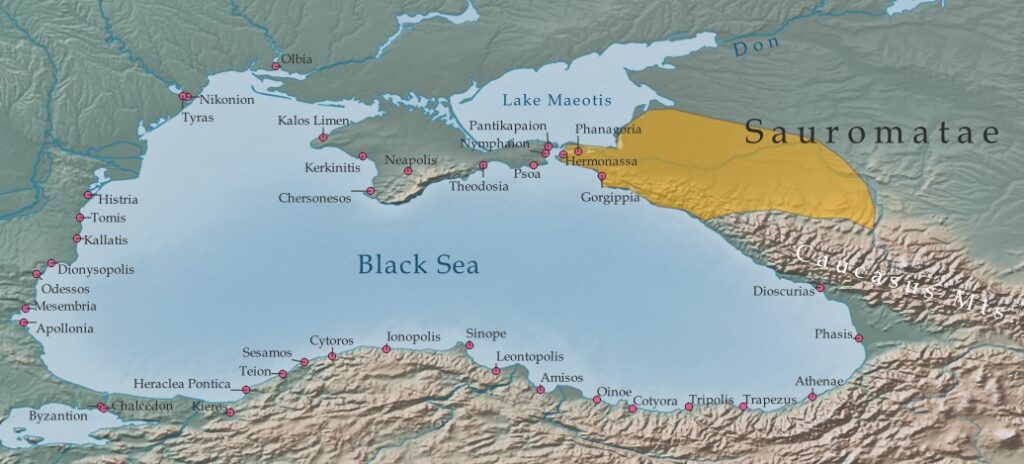
These colonies were crucial trade emporiums connecting the Mediterranean world to the trade routes of northern Europe and Central Asia. The Greeks traded with the local peoples, exchanging goods such as grain, fish, honey, and furs, as well as metals and slaves – all resources that were abundant in this region.
These colonies brought the Greeks in direct contact with the Scythian tribes who inhabited the steppe regions to the north of the Black Sea. And many Scythian slaves were brought to Greece.
Change in Depiction
The earliest identifiable depiction of an Amazon in Greek art appears on a small terra-cotta shield from c. 700 BC.[12][D] These early portrayals of Amazons depict them as essentially Greek, wearing chitons, Greek armor and helmets, and wielding round shields.
But around 550 BC there was a dramatic and sudden change in these depictions. Greek vase painters began to portray Amazons dressed in Scythian attire and wielding Scythian weapons.
This date, 550 BC, is precisely the time when the first Greek colonies were founded on the northeastern coast of the Black Sea.
Sauromatae slaves brought to Greece undoubtedly contributed to the change in depiction of the Amazons.
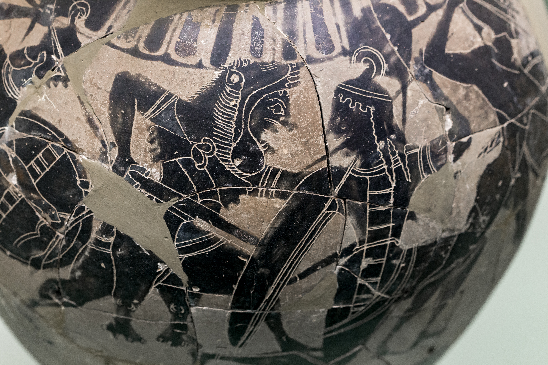
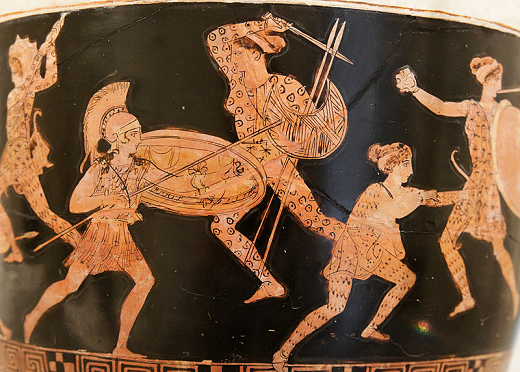
This leads us to the main point of this post.
Before the Greek colonized the northeastern shore of the Black Sea, before they came into contact with tribes of the Sauromatae, Amazons were deemed purely mythical.
This means that Homer and writers predating 550 BC did not have first-hand knowledge of Amazons, but were simply retelling ancient stories.[E]
But the fact that the Amazons were real gives historical merit to stories like the Iliad and the Odyssey and Greek Mythology in general.
Conclusion
Before Greek colonization of the Sauromatae coast, the Amazons were considered no different than other mythological tribe. Before this time, the Amazons were just as real as the Cyclopes, Centaurs, nine-headed serpents, and the Trojan War.
This is important to understand because the fact that the Amazons were historical suggests that all of Greek Mythology may be historical.
In Part IVb we will explore how the myths of the Amazons evolved over time. If we can understand where these stories came from, how they were conceptualized, and how they changed, then we can begin to objectively evaluate all other Greek myths.
Notes
[A] As we mentioned in Part I, the word Amazon means “warrior” in Proto-Iranian (from which the Scythian language derived). We might imagine that the first Greeks to encounter these women asked what they called themselves, and Amazons was their response. Which is a pretty badass response.
[B] The Mushki are usually equated with the Moschoi of Greek sources and the Meskhi tribe of Georgia. The Urumu are thought to be the ancestors of the Armenians. Both of these tribes appear to have inhabited the Armenian highlands in the 12th century BC.
[C] The Late Bronze Age Collapse (LBAC) is an absolutely fascinating topic which we will get into after we cover the Trojan War. It refers to the period of time at the end of the Bronze Age which saw the socio-political (and economic) breakdown of civilization in the eastern Mediterranean at the start of the 12th century BC. It is characterized by widespread depopulation, mass migration, and extreme violence — the causes of which are fiercely debated today.
[D] Before c. 700 BC, human figures did not appear in Greek art; most designs featured purely geometric patterns.
[E] These stories originated in the Bronze Age when the Greeks were in contact with the Amazons in Anatolia. They were transmitted for hundreds of years and written down at a time when Greek-speaking peoples were no longer in contact with the Amazons.
Sources
[1] The Kingdom of the Hittites, p. 388, Trevor Bryce (1998)
[2] Kaska (Gaska) and Hittite Struggle around Samsun Region, Dursun Sagdis (2019)
[3] Strabo 11.5.1-2
[4] Herodotus 4.110-117
[5] Ephorus fragment 103
[6] Scymnus of Chios 5.102
[7] Plato Laws 7.806b
[8] Diodorus Siculus 2.34
[9] Remarks on the Presence of Iranian Peoples in Europe and their Asiatic Relations, p. 105-107, Marek Jan Olbrycht (2000)
[10] Pomponius Mela 1.114
[11] The Cambridge History of Early Inner Asia, p. 97, A. I. Melyukova (1990)
[12] The Amazons: Lives and Legends of Warrior Women across the Ancient World, Adrienne Mayor (2014)

